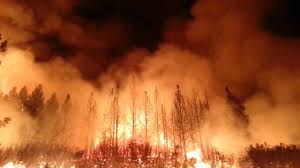Five statewide groups hoping to capitalize on the public’s attention after a fiery summer are exploring a new nonpartisan partnership that will push for cash and other tools to treat thousands of acres of forests and watersheds ravaged by super-hot, long-burning blazes.
Led by the Colorado Water Congress, which represents water providers, the founding group includes The Nature Conservancy, the Colorado Timber Industry Association, the Colorado Agricultural Water Alliance and Club 20, a West Slope economic development group.
“We’re seeing more fires and bigger fires,” said Molly Pitts, executive director of the timber association. “As scary as that is, it’s the after effects that are far more devastating.”
Forested mountain slopes that are scraped bare by fires are more likely to flood during summer rain storms, causing sediment flows that can clog streams and water collection systems. That was the case this summer once the 416 fire near Durango was snuffed out, with flooding causing mud slides that destroyed property and overwhelmed parts of the Animas River, among others.
When fires burn around water systems, the damage to reservoirs and collection systems can be crippling.
Denver was one of the first water utilities to experience the pain of a super-hot wildfire. In 2002, roughly 138,000 acres burned around its collection system during the Hayman Fire, which remains the state’s largest blaze.
Now the agency is spending $16.6 million, in conjunction with the U.S. Forest Service, to treat 50,000 acres in the Pike, San Isabel, Arapahoe, Roosevelt and White River National Forests through what’s known as the Forest to Faucets program.
Underlying the fire danger is the damage done by pine and spruce beetles. Of Colorado’s 24.4 million forested acres, more than 5.1 million, or roughly 26 percent, have been weakened by insect infestations, according to the Colorado Forest Service. As damaged trees age, die and fall down, they create piles of wood that burn readily in the state’s increasingly hot, dry summers.
In a year like this one, when mountain snowpacks were ultra low and provided little moisture to hillsides, the fire season started early, erupting in May and continuing even now.
If there’s any upside to such natural disasters, in Pitts’ view, it’s the public’s increased awareness of both wildfire risk and, equally important, the connection between healthy, fire-resistant forests and public water supplies.
“There is always a short window after a fire to get the public energized in understanding the issue,” Pitts said.
Having an umbrella group capable of connecting the dots for lawmakers and the public could help secure funding and advance certain strategies, such as cultivating new timber product companies to buy the trees felled and collected as part of thinning operations. When those trees can be sold, the revenue helps offset cleanup costs.
“We don’t want to duplicate what others are doing,” said Ellen Roberts, a Durango attorney and former lawmaker who is spearheading the effort. “But we do want to explore whether having a high-level advocacy group conveying this message would be effective.”
Keith Stagg oversees forest mitigation for the Northern Colorado Water Conservancy District, which manages the Colorado-Big Thompson Project. Its collection system spans parts of the Colorado River headwaters region in Rocky Mountain National Park and includes Lake Granby. Northern, like other water providers, is doing more to protect the forests around its reservoirs.
“There are a lot of groups working in this area,” Stagg said, “and it can feel like musical chairs with different priorities. It would be nice to have an overarching organization to help organize all of the groups.”
The players backing the proposed alliance are meeting in Vail today at the Colorado Water Congress summer conference for additional talks. Roberts said if they decide to move forward, they would like to be up and running in time for the 2019 session of the Colorado Legislature, which convenes Jan. 4, 2019.
Colorado would become only the second state in the nation to form such a group, Roberts said. California was the first state to do so, founding the California Forest Watershed Alliance in 2014.
Jerd Smith is editor of Fresh Water News. She can be reached at 720-398-6474, via email at jerd@wateredco.org or @jerd_smith. Fresh Water News is an independent, non-partisan news initiative of Water Education Colorado. Our editorial policy can be viewed here.


 Print
Print